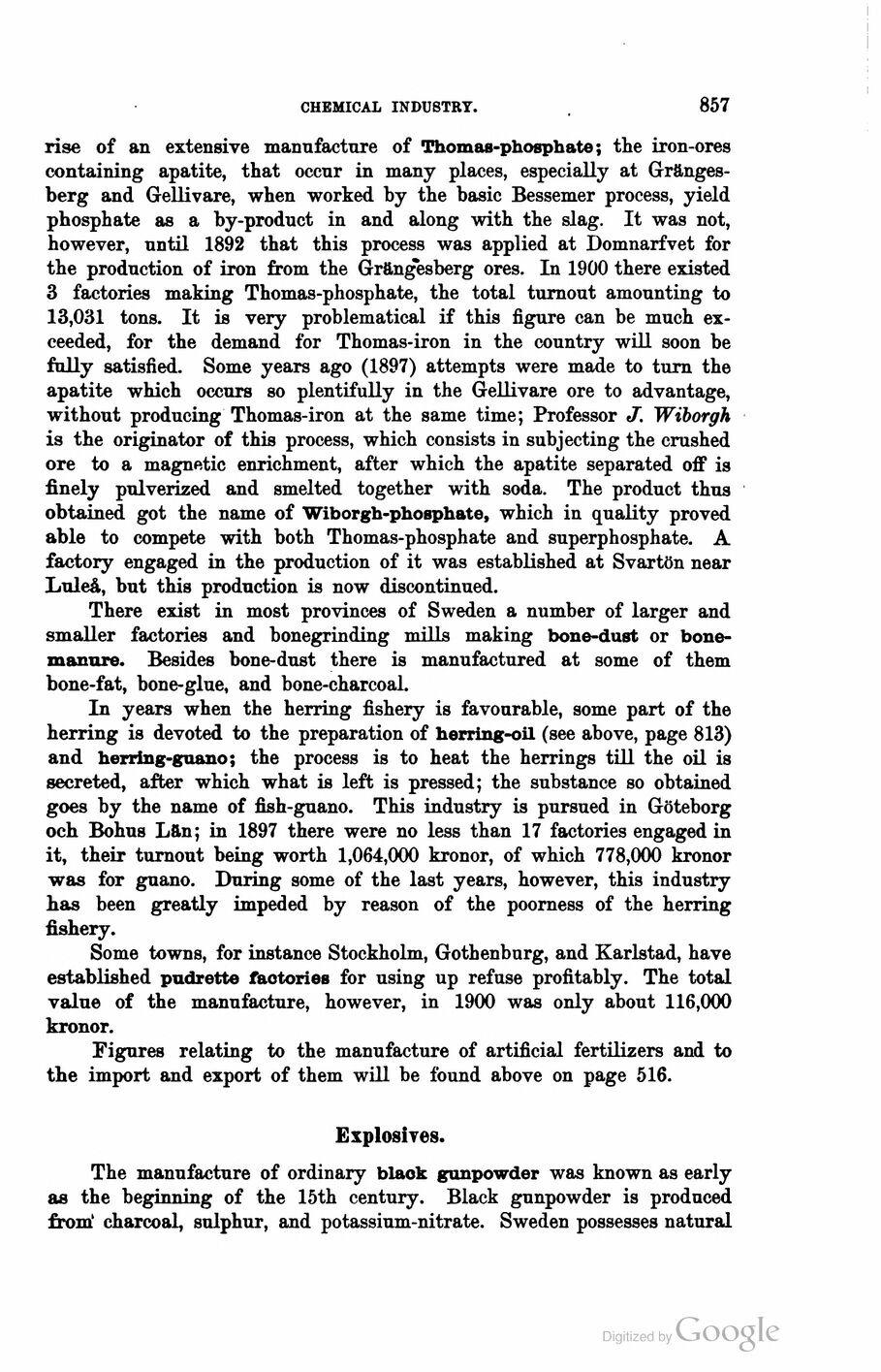
Full resolution (JPEG) - On this page / på denna sida - Second part - X. Manufacturing Industries. By Å. G. Ekstrand, Ph. D., Chief Engineer, Control Office of the Department of Finance - 9. Chemical Industry - Artificial Fertilizers - Explosives

<< prev. page << föreg. sida << >> nästa sida >> next page >>
Below is the raw OCR text
from the above scanned image.
Do you see an error? Proofread the page now!
Här nedan syns maskintolkade texten från faksimilbilden ovan.
Ser du något fel? Korrekturläs sidan nu!
This page has never been proofread. / Denna sida har aldrig korrekturlästs.
chemical industry.
857
rise of an extensive manufacture of Thomas-phosphate; the iron-ores
containing apatite, that occur in many places, especially at
Grängesberg and Gellivare, when worked by the basic Bessemer process, yield
phosphate as a by-product in and along with the slag. It was not,
however, until 1892 that this process was applied at Domnarfvet for
the production of iron from the Gräng*esberg ores. In 1900 there existed
3 factories making Thomas-phosphate, the total turnout amounting to
13,031 tons. It is very problematical if this figure can be much
exceeded, for the demand for Thomas-iron in the country will soon be
fully satisfied. Some years ago (1897) attempts were made to turn the
apatite which occurs so plentifully in the Gellivare ore to advantage,
without producing Thomas-iron at the same time; Professor J. Wiborgh
is the originator of this process, which consists in subjecting the crushed
ore to a magnetic enrichment, after which the apatite separated off is
finely pulverized and smelted together with soda. The product thus
obtained got the name of Wiborgh-phosphate, which in quality proved
able to compete with both Thomas-phosphate and superphosphate. A
factory engaged in the production of it was established at Svartön near
Luleå, but this production is now discontinued.
There exist in most provinces of Sweden a number of larger and
smaller factories and bonegrinding mills making bone-dust or
bone-manure. Besides bone-dust there is manufactured at some of them
bone-fat, bone-glue, and bone-charcoal.
In years when the herring fishery is favourable, some part of the
herring is devoted to the preparation of herring-oil (see above, page 813)
and herring-guano; the process is to heat the herrings till the oil is
secreted, after which what is left is pressed; the substance so obtained
goes by the name of fish-guano. This industry is pursued in Göteborg
och Bohus Län; in 1897 there were no less than 17 factories engaged in
it, their turnout being worth 1,064,000 kronor, of which 778,000 kronor
was for guano. During some of the last years, however, this industry
has been greatly impeded by reason of the poorness of the herring
fishery.
Some towns, for instance Stockholm, Gothenburg, and Karlstad, have
established pudrette factories for using up refuse profitably. The total
value of the manufacture, however, in 1900 was only about 116,000
kronor.
Figures relating to the manufacture of artificial fertilizers and to
the import and export of them will be found above on page 516.
Explosives.
The manufacture of ordinary blaok gunpowder was known as early
as the beginning of the 15th century. Black gunpowder is produced
from’ charcoal, sulphur, and potassium-nitrate. Sweden possesses natural
<< prev. page << föreg. sida << >> nästa sida >> next page >>